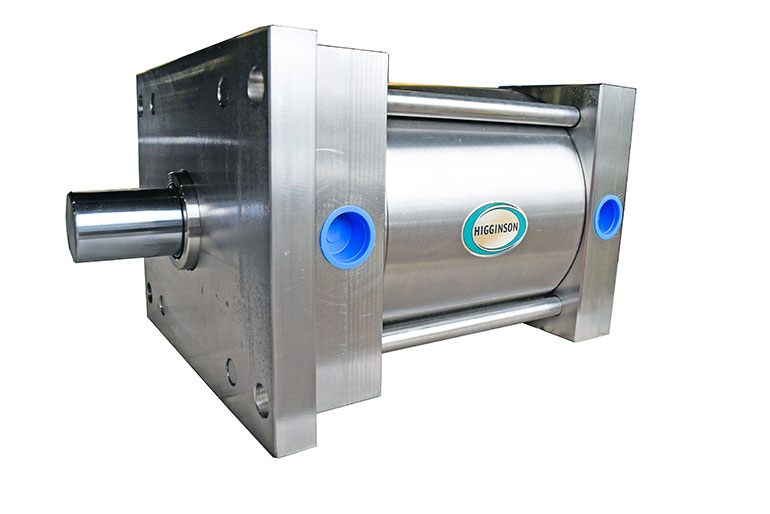By Josh Cosford, Contributing Editor
Stainless steel air and hydraulic cylinders are used in applications where corrosion resistance is the utmost priority. Standard cylinders are made from combinations of alloy steel, such as 1018, 1045 and 4140, which are all susceptible to oxidation and rust in humid or wet applications. Even when epoxy painted, carbon steel cylinders exposed to surface abrasion, dents or harsh chemicals can wear away any paint, leaving exposed steel to corrode.

Image courtesy of Higginson Equipment
Marine environments often require the usage of stainless steel cylinders, both onshore and offshore. Saltwater is especially damaging to standard alloy steel, which will rust rapidly when exposed to saline. Maritime cylinders used for cranes, boat lifts, davits or other machinery do well when made from stainless steel alloys.
Offshore oil rigs are especially prone to aqueous corrosion, and although special construction and coatings can mitigate some oxidation, the nature of pneumatic and hydraulic cylinders makes them more prone to corrosion. Manufacturing cylinders in 316-grade stainless steel produces an especially resistant raw material for offshore applications.
Stationary marine applications are only half of the equation when it pertains to the effectiveness of stainless steel. Shipbuilders use stainless actuators in locations most prone to corrosion, such as trim actuators, steering components or life craft hoists. An onshore crane failure will just be annoying and time-consuming to repair, but the failure of a steering cylinder could be deadly, so all precautions must be taken to encourage reliability. Stainless actuators are often the best answer.
Environments containing caustic or corrosive chemicals will make do with stainless steel cylinders as well. Although poor for marine applications, 304 stainless steel works well in the metals industry where chemicals like sodium hydroxide are used in the cleaning process. Another tough environment requiring the use of stainless cylinders are pulp and paper mills. The black liquor by-product is extremely corrosive to steel, so 304 stainless comes to the rescue once again, extending the life of linear actuators in demanding applications. That being said, even stainless cylinders will eventually corrode when exposed to black liquor, showing you how demanding the environment is.
Sometimes a cylinder must not only resist the damaging effects of its ambient environment, but it must also aid in the protection and safety of that environment as well. Food grade applications often require stainless steel air and hydraulic cylinders. Indeed, they excel here because food applications are often damp or altogether wet. A bottling plant, for example, uses stainless steel extensively, not just for extended life of the machinery, but to prevent corroding or rusting machinery from contaminating the product.
Because stainless steel is less likely to rust, its surface finish remains true for longer periods of humid exposure. A clean, smooth surface prevents the adhesion and accumulation of food particles and bacteria, which is clearly the top concern for food and beverage production.
Food grade cylinders are manufactured to different standards compared to “off-the-shelf” cylinders, with features added to reduce the accumulation of bacteria. For example, a quality stainless air cylinder used in food and beverage might have a polished surfaced to prevent bacterial adhesion, rounded corners to reduce burrs and welded or threaded construction to eliminate cavities or pockets. Typical tie-rod cylinders, for example, provide hiding spaces under the tie rod locations, making washdown less effective.
Food grade applications can be so extreme as to eliminate externally adjustable cushions, which provide a pocket for food and bacteria to reside. Cushions may still exist but will be the non-adjustable type without any exterior cross drillings. Even the rod wiper may be manufactured from food grade polymers to prevent cross-contamination. Although stainless steel cylinders are more costly than standard steel alloys, some applications absolutely require their superior corrosion resistance properties.
Filed Under: Cylinders & Actuators, Fluid Power Basics